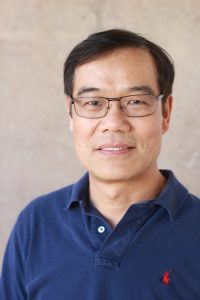 Bin Nan, Professor of Statistics, joined the ICS faculty in September 2017.
Bin Nan, Professor of Statistics, joined the ICS faculty in September 2017.
Q: Can you tell us about your background?
I did my undergraduate work and received my first master’s degree in aerospace engineering in China. I later came to the U.S. to study statistics on a full scholarship at the Virginia Commonwealth University, where I did my master’s degree in the math department, with a statistics focus. During that time, a fellow student recommended a course called “Survival Analysis,” which I had never heard of. However, when he described it, I said, “that’s called ‘reliability’ in engineering.” After realizing it was exactly the field I wanted to study, I consulted with a few people and ended up going to the University of Washington on a full scholarship. So my wife, our young son and I drove across country to Seattle, which was beautiful.
Although I worked with Norm Breslow, a professor of biostatistics, as a research assistant, I chose to work with Jon Wellner, a professor of statistics, on my dissertation topic: the efficiency theory for two-phase sampling designs with censored survival data. I spent nearly two years not making much progress, but I finally solved the problem — while Wellner and Breslow were hiking in the Himalayas for a month — after obtaining the efficiency bounds for case-cohort designs. After graduating in 2001 with a Ph.D. in biostatistics, I went to the University of Michigan, where I taught for 16 years.
Q: What brought you to UCI?
Aside from the Southern California weather, the driving factor was the research opportunity related to Alzheimer’s disease. At the University of Michigan, after getting tenured, I started working at the Michigan Alzheimer’s Disease Research Center and found the work very interesting, particularly the work on imaging data. The challenge is trying to handle the huge amount of data collected on a relatively small number of patients, because classical statistical methods don’t work; we have to develop new approaches. Unfortunately, after 20 years of support from the National Institute on Aging, the center lost its funding due to a lack of clinical leadership in Alzheimer’s research, and while research continued on other neuro diseases, there weren’t many people I could collaborate with on Alzheimer’s.
So when I learned about the job opportunity at UCI from Dan Gillen (professor and chair of the Department of Statistics) — we were students at the University of Washington together and had interacted over the years on Alzheimer’s research — I decided to apply. For this particular field, and for neuroimaging, there’s much more research going on here at UCI, and I really enjoyed my interactions with the faculty I met during my interview. So I accepted the position and moved here in August.
Q: What courses will you be teaching?
In the winter, I’ll be teaching two classes for master’s students. One is an applied course on categorical data analysis. The second is a theoretical course on mathematical statistics. In the spring, I’ll teach an advanced topic class on survival analysis.
Q: Can you talk about a bit your health research?
My research is primarily motivated from my collaborations with biomedical researchers. Besides Alzheimer’s disease research, I have collaborated with epidemiologists at Michigan over a decade studying women’s health during the menopausal transition, understanding hormonal changes and their associations with age at menopause and with health status such as bone mineral density changes, diabetes and many other things. I was also the statistical consultant for the radiology department at the University of Michigan for many years, helping investigators with study designs, data analysis and the interpretation of statistical results. Most of the work focused on evaluating imaging diagnosis techniques, including CT, MRI, ultrasound and PET.
Q: What do you like best so far about UCI?
The collaborative opportunities. When I was in the biostatistics department, the focus was on health research. Here, in a statistics department, I think the setup is ideal for lots of different research activities, especially because the statistics, informatics and computer science departments are in the same school. Statisticians and computer science researchers have different cultures, and we each have our strengths and weaknesses, but I think being in the same school presents opportunities to work together on all kinds of research problems — big data and data science, artificial intelligence, engineering projects, or anything else important to society that can affect people’s lives, not just health research. So I’m looking forward to learning more about the interaction between the three departments.
Q: What do you do in your spare time?
My wife and I love to go to the farmer’s market on Saturdays, and we enjoy biking a few times a week. I also like to go hiking and do yard work (though I’m still trying to figure out how to do those in Irvine), and I like watching college football. My son did his undergraduate study and went to medical school at the University of Michigan, and of course I worked there, so I’m a Michigan fan!
Q: Is there a book you’d like to recommend to students?
A good book on survival analysis is The Statistical Analysis of Failure Time Data, Second Edition, by John D. Kalbfleisch and Ross L. Prentice (John Wiley & Sons, 2002). It’s a very well-written book that’s not hard to read.